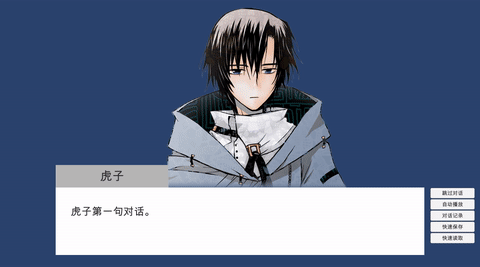前言 从 cocos creator 开始到现在用 unity 制作了很多个失败的作品,并非一无所获。
基本每一个项目都离不开对话系统,因此对话系统反反复复重置也有好几个版本。这是用新的方法实现的第五版对话系统。如何实现 GalGame 那样的对话系统一直都是一个难题,如今终于有一个比较完美的解决方案了。
那么就来看看是如何实现的吧!
基本思路 最开始要考虑的问题在于如何存储动则几万字的文本。
游戏中剧本很多的情况下就不能用简单的直接在代码上面输出文本。
如下面这种就属于硬编码,代码与文本数据耦合在一起:
1 2 // 假设这是一个对话处理类 Dialog.ShowText("你好,世界!");
游戏发售后,发现海外用户有需求,steam 上面 “we need english.” 呼声很大。
1 Dialog.ShowText("hello,world!");
如果以后又要出一个日文版,又得再改成日文的。
存储容器 WEB 开发用来存储数据的是数据库之类的东西,而单机游戏就是本地文件了。
excel 表格
txt 文本文档
json 文件
上面三个任意一个都可以用来作为保存文本的存储器,txt 和 excel 比较直观,适合多人开发且策划为不懂技术的,策划不懂技术但是可以直接在 excel 或者 txt 上面配置,这也是一般的做法;因为我就是游戏程序并且负责录入文本,所以我这里选择方便读取的 json 文件作为保存对话的容器。
插件下载 在 c# 中可以用 LitJson 插件来实现读取 json 格式的文件。
LitJson 下载:https://github.com/LitJSON/litjson
使用这个插件还有一个好处是可以直接把 json 字符串转换成对应的类的实例,下文会详细解释。
功能说明 对话系统是一个很庞大的系统,它不仅仅只是展示剧本,更是一个剧情演出的处理器。剧情演出就是画面闪烁、屏幕震动、视野改变或者让玩家等待 1 秒钟这种和游戏流程有一定关系的处理。
例如下面这是一个游戏的剧本,剧本里包含了演出效果:
1 2 3 4 5 6 7 8 9 10 11 12 [播放BGM:教室内] 小明:这次又考砸了。 小明:我的好基友不会背叛我的,一定是这样! [播放音效:脚步声] 小明:小黑,这次考了多少啊。 小黑:唔……刚好及格。 [屏幕震动] [播放音效:震惊] 小明:什么?! 小明:那这次我岂不是垫底了!
剧本通常都包含上面这样的演出效果,所以对话系统并不只是显示文字而已,也应当包含这些演出效果的处理。
数据驱动 如果是基于代码驱动,如下:
1 2 3 4 5 6 7 8 9 10 11 12 13 14 15 16 17 18 19 20 // 播放背景音乐 Sound.BGM("教室内"); // 显示第一段对话 Dialog.ShowTextCommand("0001"); // 播放音效 Sound.Play("脚步声音效"); // 显示第二段对话 Dialog.ShowTextCommand("0002"); // 屏幕震动效果 Screen.Shock(); // 播放音效 Sound.Play("震惊"); // 显示第三段对话 Dialog.ShowTextCommand("0003");
我们不可能每一段演出都要手写,如果想要节约人力,最好的方法就是用数据驱动的方式来实现。数据驱动就是通过定义一些关键词,通过解释器读取这些关键词,然后根据配置的参数自动处理。
例如定义下面的数据:
1 2 3 4 5 6 7 8 9 [ {"type":"bgm", "id":"教室内"}, {"type":"text", "id":"0001"}, {"type":"sound", "id":"脚步声音效"}, {"type":"text", "id":"0002"}, {"type":"shock"}, {"type":"sound", "id":"震惊音效"}, {"type":"text", "id":"0003"}, ]
在一个 json 文件配置好上面的参数,再写一个解释器用来将数据解析成对应的脚本逻辑。比如只要用一个 switch 结构就可以实现:
1 2 3 4 5 6 7 8 9 10 11 JsonData json = {"type":"bgm", "id":"教室内"}; switch(json["type"]) { case "bgm": Sound.BGM(json["id"]); break; case "text": Dialog.ShowTextCommand(json["id"]); break; // …… }
上面的例子就是利用数据驱动来处理演出效果。
可视化配置 使用数据驱动最大的问题就在于配置数据表,上面的 json 字符串完全是我手写的,如果是完整的剧本,要让我手写的话估计会疯掉。因此如何实现可视化配置就是一个问题了,今天来不及实现,明天我将会用老本行 WEB 开发的方式来制作一个「剧本生成器」。
命令模式 其实上面已经不知不觉接触到了「设计模式」,在设计模式中有一个叫做「命令模式」的,就是用数据驱动来实现的。关于命令模式可以自行网上查阅,这里只用一个简单的比方进行介绍:
比如夏天到了我们要开空调,然后用遥控器打开空调开关,然后按加减键来调节温度。这就是命令模式了,空调插上电处于待机状态,等待接收遥控器发来的「指令」,根据发来的指令进行下一步的操作。
命令模式一共有三个角色:
比如上面的遥控器就是发布命令的人,空调就是接受命令并执行的人,而遥控器发出的信号就是传递的介质,遥控器通过信号把命令传达给空调,如果是与安全相关的还需要加密处理。
在对话系统中,三个角色就是:
命令本身就是类似:“我要你显示 xxx 文本。”,命令发布者要把这条消息发给命令的执行者,它才知道要做什么。命令发布者就是供外界调用的公开方法,别人点一下场景中的 NPC 它就会说一段话,就是调用命令发布者来执行对话的。而命令的执行者就是对话系统本身了,它具备了所有的功能,但是自己不会主动执行,而是等着别人告诉他要怎么做。
Command(命令数据) “我要你显示 xxx 文本。”,要想让执行者知道这是什么意思,就要定义一个数据结构。
所有命令的父类 Command:
1 2 3 4 5 6 7 namespace Dialog { public class Command { public string type; } }
然后再定义各种不同的命令,比如显示对话的命令 DialogCommand:
1 2 3 4 5 6 7 8 9 10 namespace Dialog { public class DialogCommand : Command { public string name; public string content; public string tachie; public string tachie_position; } }
播放音效的命令 PlaySeCommand:
1 2 3 4 5 6 7 namespace Dialog { public class PlaySeCommand : Command { public string path; } }
诸如此类。
还有,就是上面说到的 LitJson 本身内置一个很好用的功能:将 json 字符串转化成对应的类。
Invoker(祈求者) 这是一个祈求命令的类,就是命令发布者。外界只要调用这个类的 Execute 方法就会开始执行对话;这里声明了一个 List 结构用来存储命令数据,这样做的好处是可以方便的回溯到任意一个命令开始的地方,比如玩家想看之前的一段剧情,就只要修改 currentIndex(当前命令的索引)即可从任意的位置重新开始,比如我就定义了一个 Prev(上一条对话),避免玩家因为手速太快没看清楚,还可以重新再看一遍。
因为把所有的命令都保存下来了,所以要实现『历史对话记录』也很简单。
Invoker 代码如下:
1 2 3 4 5 6 7 8 9 10 11 12 13 14 15 16 17 18 19 20 21 22 23 24 25 26 27 28 29 30 31 32 33 34 35 36 37 38 39 40 41 42 43 44 45 46 47 48 49 50 51 52 53 54 55 56 57 58 59 60 61 62 63 64 65 66 67 68 69 70 71 72 73 74 75 76 77 78 79 80 81 82 83 84 85 86 87 88 89 90 91 92 93 94 95 96 97 98 99 100 101 102 103 104 105 106 107 108 109 110 111 112 113 114 115 using System.Collections; using System.Collections.Generic; using UnityEngine; using LitJson; using System; namespace Dialog { public class Invoker : MonoBehaviour { public Receiver receiver; bool isDisabled, isPressed; int currentIndex; List<Command> commands = new List<Command>(); public void Execute(string command) { receiver.SetPrevBtnEnabled(false); TextAsset textAsset = Resources.Load<TextAsset>("Dialog/" + command); JsonData data = JsonMapper.ToObject(textAsset.text); foreach (JsonData item in data) { Debug.Log(item["type"]); AddCommond(item); } currentIndex = 0; receiver.Execute(commands[currentIndex]); } private void AddCommond(JsonData item) { string json = item.ToJson(); switch (item["type"].ToString()) { case "DialogCommand": commands.Add(JsonMapper.ToObject<DialogCommand>(json)); break; case "PlaySeCommand": commands.Add(JsonMapper.ToObject<PlaySeCommand>(json)); break; case "WaitCommand": commands.Add(JsonMapper.ToObject<WaitCommand>(json)); break; } } public void OnExecutedCallback(bool autoNext = false) { if (autoNext) { NextCommand(); } else { isDisabled = false; } } public void NextCommand() { isDisabled = true; currentIndex++; if (currentIndex >= commands.Count) { receiver.OnCompleted(); } else { receiver.SetPrevBtnEnabled(true); receiver.Execute(commands[currentIndex]); } } public void PrevCommand() { isDisabled = true; currentIndex--; if (currentIndex <= 0) { currentIndex = 0; receiver.SetPrevBtnEnabled(false); } receiver.Execute(commands[currentIndex]); } private void Update() { if (isDisabled || isPressed) return; if (Input.GetKeyDown(KeyCode.Space)) { isPressed = true; } } private void FixedUpdate() { if (isPressed && Input.GetKeyUp(KeyCode.Space)) { isPressed = false; NextCommand(); } } } }
Receiver(命令接收和执行者) 首先在场景中拼好对话 UI:
Receiver 类就是对话系统本身,它包括解析命令数据,并且将命令转化为真正的逻辑。它每次只执行一条命令,执行完毕之后立刻通知 Invoker,告诉它命令已经执行完了,然后再由 Invoker 来决定接下来要执行的新命令。
1 2 3 4 5 6 7 8 9 10 11 12 13 14 15 16 17 18 19 20 21 22 23 24 25 26 27 28 29 30 31 32 33 34 35 36 37 38 39 40 41 42 43 44 45 46 47 48 49 50 51 52 53 54 55 56 57 58 59 60 61 62 63 64 65 66 67 68 69 70 71 72 73 74 75 76 77 78 79 80 81 82 83 84 85 86 87 88 89 90 91 92 93 94 95 96 97 98 99 100 101 102 103 104 105 106 107 108 109 110 111 112 113 114 115 116 117 118 119 120 121 122 123 124 125 126 127 128 129 130 131 using System; using System.Collections; using System.Collections.Generic; using UnityEngine; using UnityEngine.UI; using Core; namespace Dialog { public class Receiver : MonoBehaviour { public Invoker invoker; public Image tachie; public GameObject panel, nameBG, contentBG; public GameObject skipBtn, prevBtn, autoBtn, logBtn, saveBtn, loadBtn; public Text nameText, contentText; // 立绘缓存 Dictionary<string, Sprite> tachieCaches; private void Awake() { tachieCaches = new Dictionary<string, Sprite>(); } Sprite GetTachieFromCache(string key) { if (tachieCaches.ContainsKey(key)) { return tachieCaches[key]; } string fullPath = "Tachie/" + key; Sprite sprite = Resources.Load<Sprite>(fullPath); if (sprite == null) { Debug.LogError(fullPath + "不存在"); } tachieCaches.Add(key, sprite); return sprite; } public void Execute(Command command) { switch (command.type) { case "DialogCommand": DialogAction(command as DialogCommand); break; case "PlaySeCommand": PlaySeAction(command as PlaySeCommand); break; case "WaitCommand": StartCoroutine(WaitAction(command as WaitCommand)); break; } } /** * 非对话命令结束后,需要调用以隐藏对话框 * 同时重置对话框状态,如隐藏立绘 */ void SetDefaultState() { panel.SetActive(false); tachie.gameObject.SetActive(false); } IEnumerator WaitAction(WaitCommand command) { SetDefaultState(); yield return new WaitForSeconds((float)command.time); invoker.OnExecutedCallback(true); } void PlaySeAction(PlaySeCommand command) { SetDefaultState(); invoker.OnExecutedCallback(true); } void DialogAction(DialogCommand command) { panel.SetActive(true); // 是否展示立绘 if (command.tachie != "") { string path = command.name + "/" + command.tachie; tachie.sprite = GetTachieFromCache(path); tachie.gameObject.SetActive(true); // 防止图片变形恢复原本大小 tachie.rectTransform.sizeDelta = tachie.sprite.rect.size; } else { tachie.gameObject.SetActive(false); } // 是否展示名称 if (command.name != "") { nameBG.SetActive(true); nameText.text = LocaleManager.GetLocaleText("name", command.name); } else { nameBG.SetActive(false); } contentText.text = LocaleManager.GetLocaleText(command.name, command.content); invoker.OnExecutedCallback(); } public void SetPrevBtnEnabled(bool res) { prevBtn.SetActive(res); } public void OnCompleted() { Destroy(gameObject); } } }
LocaleManager(本地化处理) 为了方便以后扩展出其他语言版本,所以提前做好本地化的准备:
1 2 3 4 5 6 7 8 9 10 11 12 13 14 15 16 17 18 19 20 21 22 23 24 25 26 27 28 29 30 31 32 33 34 35 36 37 38 39 40 using System.Collections; using System.Collections.Generic; using UnityEngine; using LitJson; namespace Core { public class LocaleManager : MonoBehaviour { public static Dictionary<string, JsonData> locales = new Dictionary<string, JsonData>(); public static void LoadLocaleSetting() { string locale = GetLocaleLanguage(); string path = "Locale/" + locale; TextAsset[] textAssets = Resources.LoadAll<TextAsset>(path); foreach (var text in textAssets) { locales[text.name] = JsonMapper.ToObject(text.text); } } public static string GetLocaleText(string field, string key) { if (locales.ContainsKey(field)) { return locales[field][key].ToString(); } return "null"; } public static string GetLocaleLanguage() { return "zh-cn"; } } }
这个类实现了读取本地语言的文件功能,目前只有 zh-cn(简体中文)。
语言文件 由于本地化语言都是动态读取的,因此放到 Resources 文件夹下面。
如 name.json 文件用来保存人物名字:
1 2 3 4 { "huzi": "虎子", "huahua": "花花" }
还有对应角色的台词,如 huzi.json:
1 2 3 4 { "00001": "虎子第一句对话。", "00002": "虎子第二句对话。" }
最后是命令也需要一个 json,编号为 00001:
1 2 3 4 5 6 7 8 9 10 11 12 13 14 15 16 17 18 19 20 21 22 23 24 25 26 27 28 29 30 31 32 33 34 35 36 37 38 [ { "type": "DialogCommand", "tachie": "normal", "tachie_position": "left", "name": "huzi", "content": "00001" }, { "type": "PlaySeCommand", "path": "movement" }, { "type": "WaitCommand", "time": 1 }, { "type": "DialogCommand", "tachie": "normal", "tachie_position": "left", "name": "huahua", "content": "00001" }, { "type": "DialogCommand", "tachie": "smile", "tachie_position": "left", "name": "huzi", "content": "00002" }, { "type": "DialogCommand", "tachie": "smile", "tachie_position": "left", "name": "huahua", "content": "00002" } ]
命令里加入一个 type 字段来识别不同的类(用来规范化)。
演示效果 调用起来也非常简单:
1 2 3 GameObject obj = Util.ObjectBuilder.CreateObject("Prefab/UI/Dialog", canvas); Dialog.Invoker invoker = obj.GetComponent<Dialog.Invoker>(); invoker.Execute("00001");
上面的 00001 即是命令文件的名字,即 00001.json。
最后进入游戏演示:
作者的话 这是历经了很多次失败最终总结的成果,虽然游戏没做出来一个,系统倒是完善了不少。
这套对话系统的可扩展性很强,以后应该都可以基于这套系统进行深度化的定制了。




